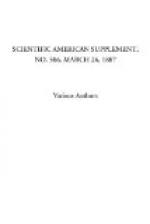Note.—This is the method employed generally in small dye-works for all dresses for black; their lots are so small. This preparation can be kept up, if care is taken that none of the sediment of the copperas (oxide of iron) is introduced when charging, as the oxide of iron creates stains. This also happens when the water used contains iron in quantity or impure copperas. The remedy is to substitute half a gill of vitriol in place of tartar.
Silk, wool, and cotton mixed dresses, for black.—Dye the silk and wool as before described, and also the cotton in the manner previously mentioned.
Another method to dye the mixed silk and wool and cotton dresses black, four dresses.—Bring boiler to the boil, put in 3 or 4 oz. aniline black, either the deep black or the blue black or a mixture of the two, add 1/4 gill hydrochloric acid or sulphuric acid, or 3 oz. oxalic acid, shut off steam, enter, and handle for half an hour, lift, rinse through water, dye the cotton in the manner previously described.—Dyer.
* * * * *
FUEL AND SMOKE.
[Footnote: Second of two lectures delivered at the Royal Institution, London, on 17th April, 1886. Continued from SUPPLEMENT, No. 585, p. 9340.]
By Prof. OLIVER LODGE.
LECTURE II.
The points to which I specially called your attention in the first lecture, and which it is necessary to recapitulate to-day, are these: (1) That coal is distilled, or burned partly into gas, before it can be burned. (2) That the gas, so given off, if mixed with carbonic acid, cannot be expected to burn properly or completely. (3) That to burn the gas, a sufficient supply of air must be introduced at a temperature not low enough to cool the gases below their igniting point. (4) That in stoking a fire, a small amount should be added at a time because of the heat required to warm and distill the fresh coal. (5) That fresh coal should be put in front of or at the bottom of a fire, so that the gas may be thoroughly heated by the incandescent mass above and thus, if there be sufficient air, have a chance of burning. A fire may be inverted, so that the draught proceeds through it downward. This is the arrangement in several stoves, and in them, of course, fresh coal is put at the top.
Two simple principles are at the root of all fire management: (1) Coal gas must be at a certain temperature before it can burn; and (2) it must have a sufficient supply of air. Very simple, very obvious, but also extremely important, and frequently altogether ignored. In a common open fire they are both ignored. Coal is put on the top of a glowing mass of charcoal, and the gas distilled off is for a longtime much too cold for ignition, and when it does catch fire it is too mixed with carbonic acid to burn completely or steadily. In order to satisfy the first condition better, and keep the gases at a higher temperature, Dr. Pridgin Teale arranges a sloping fire-clay slab above his fire. On this the gases play, and its temperature helps them to ignite. It also acts as a radiator, and is said to be very efficient.




